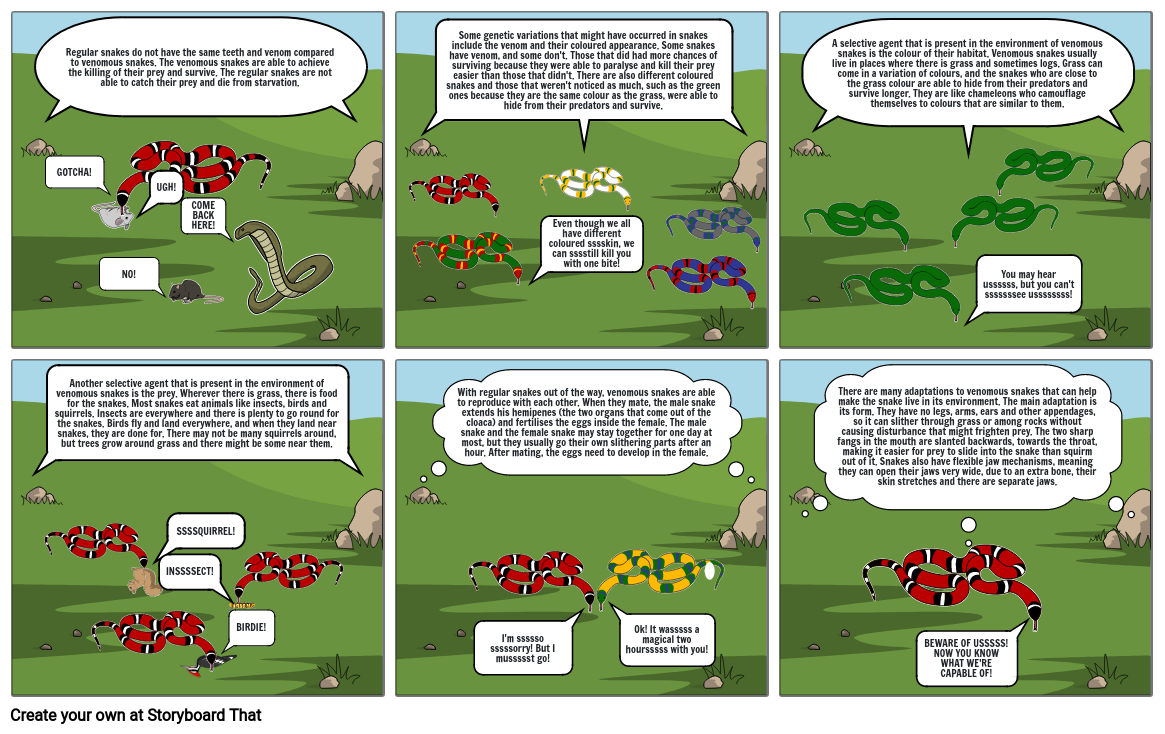Venom in Snakes by Natural Selection Joshua Velasquez

Texto del Guión Gráfico
- Regular snakes do not have the same teeth and venom compared to venomous snakes. The venomous snakes are able to achieve the killing of their prey and survive. The regular snakes are not able to catch their prey and die from starvation.
- GOTCHA!
- NO!
- UGH!
- COME BACK HERE!
- Some genetic variations that might have occurred in snakes include the venom and their coloured appearance. Some snakes have venom, and some don't. Those that did had more chances of surviving because they were able to paralyse and kill their prey easier than those that didn't. There are also different coloured snakes and those that weren't noticed as much, such as the green ones because they are the same colour as the grass, were able to hide from their predators and survive.
- Even though we all have different coloured sssskin, we can sssstill kill you with one bite!
- A selective agent that is present in the environment of venomous snakes is the colour of their habitat. Venomous snakes usually live in places where there is grass and sometimes logs. Grass can come in a variation of colours, and the snakes who are close to the grass colour are able to hide from their predators and survive longer. They are like chameleons who camouflage themselves to colours that are similar to them.
- You may hear ussssss, but you can't sssssssee ussssssss!
- Another selective agent that is present in the environment of venomous snakes is the prey. Wherever there is grass, there is food for the snakes. Most snakes eat animals like insects, birds and squirrels. Insects are everywhere and there is plenty to go round for the snakes. Birds fly and land everywhere, and when they land near snakes, they are done for. There may not be many squirrels around, but trees grow around grass and there might be some near them.
- SSSSQUIRREL!
- BIRDIE!
- INSSSSECT!
- With regular snakes out of the way, venomous snakes are able to reproduce with each other. When they mate, the male snake extends his hemipenes (the two organs that come out of the cloaca) and fertilises the eggs inside the female. The male snake and the female snake may stay together for one day at most, but they usually go their own slithering parts after an hour. After mating, the eggs need to develop in the female.
- I'm ssssso sssssorry! But I mussssst go!
- Ok! It wasssss a magical two hoursssss with you!
- There are many adaptations to venomous snakes that can help make the snake live in its environment. The main adaptation is its form. They have no legs, arms, ears and other appendages, so it can slither through grass or among rocks without causing disturbance that might frighten prey. The two sharp fangs in the mouth are slanted backwards, towards the throat, making it easier for prey to slide into the snake than squirm out of it. Snakes also have flexible jaw mechanisms, meaning they can open their jaws very wide, due to an extra bone, their skin stretches and there are separate jaws.
- BEWARE OF USSSSS! NOW YOU KNOW WHAT WE'RE CAPABLE OF!
Más de 30 millones de guiones gráficos creados

